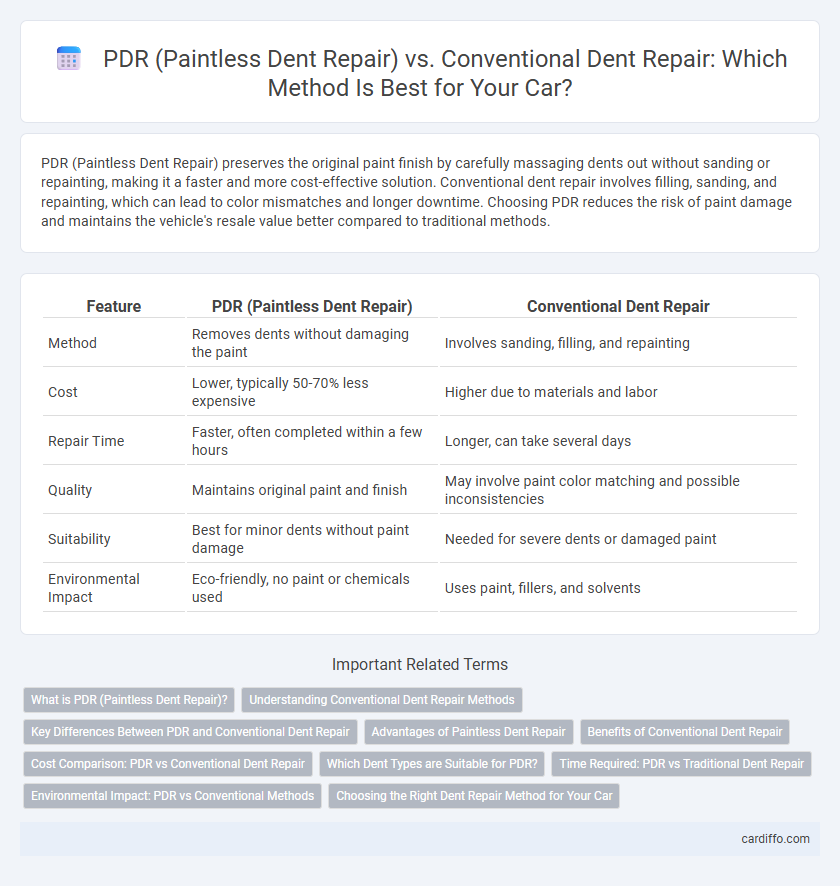PDR (Paintless Dent Repair) preserves the original paint finish by carefully massaging dents out without sanding or repainting, making it a faster and more cost-effective solution. Conventional dent repair involves filling, sanding, and repainting, which can lead to color mismatches and longer downtime. Choosing PDR reduces the risk of paint damage and maintains the vehicle's resale value better compared to traditional methods.
Table of Comparison
| Feature | PDR (Paintless Dent Repair) | Conventional Dent Repair |
|---|---|---|
| Method | Removes dents without damaging the paint | Involves sanding, filling, and repainting |
| Cost | Lower, typically 50-70% less expensive | Higher due to materials and labor |
| Repair Time | Faster, often completed within a few hours | Longer, can take several days |
| Quality | Maintains original paint and finish | May involve paint color matching and possible inconsistencies |
| Suitability | Best for minor dents without paint damage | Needed for severe dents or damaged paint |
| Environmental Impact | Eco-friendly, no paint or chemicals used | Uses paint, fillers, and solvents |
What is PDR (Paintless Dent Repair)?
Paintless Dent Repair (PDR) is a technique that removes minor dents and dings from vehicle surfaces without affecting the original paint finish. Unlike conventional dent repair, which often requires sanding, filling, and repainting, PDR uses specialized tools to carefully massage the metal back to its original shape. This method preserves the factory paint, reduces repair time, and maintains the vehicle's resale value.
Understanding Conventional Dent Repair Methods
Conventional dent repair methods involve sanding, filling, and repainting affected areas to restore the vehicle's surface, often requiring more time and higher costs compared to Paintless Dent Repair (PDR). This process can compromise the original factory paint finish and may lead to color mismatches or reduced resale value. Understanding these factors is critical for vehicle owners when deciding between conventional dent repair and the less invasive PDR technique.
Key Differences Between PDR and Conventional Dent Repair
PDR (Paintless Dent Repair) preserves the vehicle's original paint by carefully massaging dents from the inside, avoiding the need for fillers or repainting, which contrasts with conventional dent repair that typically involves sanding, filling, and repainting damaged areas. PDR is faster and more cost-effective, especially for minor to medium dents, while conventional repair can address more severe damage but requires longer downtime and higher expense. The choice impacts vehicle value retention since PDR maintains factory finishes, whereas conventional repairs can sometimes result in color mismatches or reduced resale value.
Advantages of Paintless Dent Repair
Paintless Dent Repair (PDR) offers significant advantages over conventional dent repair by preserving the vehicle's original paint finish, reducing the risk of color mismatch and improving resale value. PDR is faster and more cost-effective, typically requiring only a few hours compared to days for traditional bodywork and repainting. This method also minimizes environmental impact by eliminating the need for fillers, paints, and solvents commonly used in conventional repairs.
Benefits of Conventional Dent Repair
Conventional dent repair provides a comprehensive solution for severe dents, scratches, and paint damage that PDR cannot address, ensuring a flawless finish by repainting and refinishing the affected area. This method restores the original factory paint, maintaining vehicle color consistency and offering longer-lasting protection against rust and corrosion. Skilled technicians can effectively repair complex damage involving sharp creases or deep scratches, making conventional repair ideal for extensive bodywork.
Cost Comparison: PDR vs Conventional Dent Repair
Paintless Dent Repair (PDR) typically costs 30-70% less than conventional dent repair due to its non-invasive technique requiring no repainting or filler application. Conventional dent repair often involves extensive labor, painting, and materials, leading to higher expenses and longer turnaround times. PDR offers a cost-efficient solution for minor dents, preserving the original paint while reducing overall repair costs significantly.
Which Dent Types are Suitable for PDR?
Paintless Dent Repair (PDR) is ideal for minor dents where the paint surface remains intact, such as small dings, door dings, and hail damage. Conventional dent repair is necessary for deeper dents, creases, or areas with cracked or missing paint. PDR excels in fixing shallow dents on aluminum and steel panels without the need for repainting, preserving the vehicle's original finish.
Time Required: PDR vs Traditional Dent Repair
Paintless Dent Repair (PDR) typically requires significantly less time than conventional dent repair, often completing minor dents within an hour or two. Traditional dent repair involves processes like sanding, filling, and repainting, which can take several days depending on the extent of the damage. PDR is generally favored for its quick turnaround, saving customers both time and inconvenience.
Environmental Impact: PDR vs Conventional Methods
Paintless Dent Repair (PDR) significantly reduces environmental impact compared to conventional dent repair by eliminating the need for harmful chemicals, paints, and solvents. PDR generates minimal waste and consumes less energy, contributing to lower carbon emissions and resource use. Conventional methods typically involve repainting and using fillers, which produce VOC emissions and generate more hazardous waste, making PDR the eco-friendlier choice.
Choosing the Right Dent Repair Method for Your Car
Paintless Dent Repair (PDR) is ideal for minor dents and dings where the vehicle's paint remains intact, offering a cost-effective and time-efficient solution that preserves the original finish. Conventional dent repair involves filling, sanding, and repainting, making it suitable for more severe damage where paint is chipped or scratched, but it requires more labor and longer downtime. Choosing the right dent repair method depends on the dent size, location, and paint condition to ensure the best aesthetic and value retention for your car.
PDR (Paintless Dent Repair) vs Conventional dent repair Infographic

 cardiffo.com
cardiffo.com